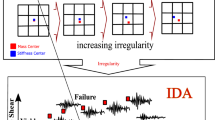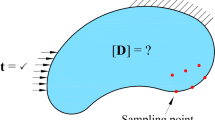Abstract
In this study, a novel two-stage plastic-state detection strategy is studied. In the first stage, discrete wavelet transform (DWT) is used to obtain the low-frequency response signal. The Hankel matrix is constructed with a low-frequency response signal, and singular value decomposition (SVD) is used to divide the null space and non-null space. The index degree of nonlinearity (DoN) was proposed for plasticity detection, and the corresponding limit of linearity (LLI) was constructed. In the second stage, based on DWT and fast independent component analysis, normalized source distribution vector (NSDV) was proposed to locate the structural damage. The method was verified by numerical simulation and a three-story frame test. The results show that when the structure is in an elastic state, DoN is less than LLI; when the structure enters the plastic state, DoN is larger than LLI and increases with the enhancement of plastic degree; thus, the proposed index NSDV can locate the structural damage. The proposed method can be used for structural plasticity detection and damage location, and has strong robustness and engineering practicability.


















Similar content being viewed by others
References
Ni PH, Li J, Hao H et al (2020) Reliability analysis and design optimization of nonlinear structures. Reliab Eng Syst Saf 198:106860
Xin Y, Hao H, Li J et al (2019) Bayesian based nonlinear model updating using instantaneous characteristics of structural dynamic responses. Eng Struct 183:459–474
Prawin J, Rao A, Lakshmi K (2021) Damage detection in nonlinear vibrating structures using model updating. Eng Comput. https://doi.org/10.1007/s00366-021-01397-5
Zhang L, Zhang Y, Song W et al (2021) A nonlinear damage constitutive model of PVC coated fabrics. Structures 30(1):368–377
Chen L, Mei Y, Fu J et al (2020) Study on the sensitive factors of structural nonlinear damage based on the innovation series. Int J Struct Stab Dyn 20(10):2042011
Xin Y, Li J, Hao H (2020) Damage detection in initially nonlinear structures based on variational mode decomposition. Int J Struct Stab Dyn 20(10):2042009
Zhou L, Wu S, Yang J (2008) Experimental study of an adaptive extended Kalman filter for structural damage identification. J Infrastruct Syst 14(1):42–51
Goh C, Tan K, Liu DS et al (2010) A competitive and cooperative co-evolutionary approach multi-objective particle swarm optimization algorithm design. Eur J Oper Res 202(1):42–54
Tsiavos A, Markic T, Schlatter D et al (2021) Shaking table investigation of inelastic deformation demand for a structure isolated using friction-pendulum sliding bearings. Structures 31:1041–1052
Xiang Y, Koetaka Y, Okuda N (2019) Single-story steel structure with LVEM-isolated floor: elastic seismic performance and design response spectrum. Eng Struct 196:109314
Zhao YL, Xu ZD (2017) Elastic-plastic time history analysis of MR damping structure based on LQG algorithm. Appl Mech Mater 858:145–150
Wang X, Zheng GT (2016) Equivalent dynamic stiffness mapping technique for identifying nonlinear structural elements from frequency response functions. Mech Syst Signal Process 68–69:394–415
Wang J, Wierschem N, Spencer B et al (2015) Experimental study of track nonlinear energy sinks for dynamic response reduction. Eng Struct 94:9–15
Noël JP, Kerschen G (2013) Frequency-domain subspace identification of nonlinear mechanical systems. Mech Syst Signal Process 40(2):701–717
Michael F (2014) Hilbert transform methods for nonparametric identification of nonlinear time varying vibration systems. Mech Syst Signal Process 47:66–77
Prawin J, Rao A (2018) Detection of nonlinear structural behavior using time-frequency and multivariate analysis. Smart Struct Syst 22(6):711–725
Chen H, Kurt M, Lee YS et al (2014) Experimental system identification of the dynamics of a vibro-impact beam with a view towards structural health monitoring and damage detection. Mech Syst Signal Process 46:91–113
Pei JS, Masri SF (2014) Demonstration and validation of constructive initialization method for neural networks to approximate nonlinear functions in engineering mechanics applications. Nonlinear Dyn 79:2099–2119
Hadjidoukas PE, Angelikopoulos P, Papadimitriou C et al (2015) Π4U: A high performance computing framework for Bayesian uncertainty quantification of complex models. J Comput Phys 284:1–21
Hot A, Kershen G, Foltete E et al (2012) Detection and quantification of non-linear structural behavior using principal component analysis. Mech Syst Signal Process 26:104–116
Prawin J, Rao ARM, Lakshmi K (2015) Nonlinear identification of structures using ambient vibration data. Comput Struct 154:116–134
Yan AM, Golinval JC (2006) Null subspace-based damage detection of structures using vibration measurements. Mech Syst Signal Process 20(3):611–626
Prawin J, Lakshmi K, Rao ARM (2020) Structural damage diagnosis under varying environmental conditions with very limited measurements. J Intell Mater Syst Struct 31(5):665–686
Chao SH, Loh CH, Tseng MH (2014) Structural damage assessment using output-only measurement: localization and quantification. J Intell Mater Syst Struct 25(9):1097–1106
Prawin J, Rao ARM, Lakshmi K (2016) Nonlinear parametric identification strategy combining reverse path and hybrid dynamic quantum particle swarm optimization. Nonlinear Dyn 84(2):797–815
Sarmadi H, Yuen KV (2020) Early damage detection by an innovative unsupervised learning method based on kernel null space and peak‐over‐threshold. Comput Aid Civil Infrastruct Eng: 1–18.
Lee NL (2021) Application of two-stage evaluation and optimization update methods for the structural damage detection of a portal beam structure. Structures 9:684–690
Li Y, Jiang R, Tapia J et al (2020) Structural damage identification based on short-time temporal coherence using free-vibration response signals. Measurement 151:107209
Mousavi AA, Zhang C, Masri SF et al (2021) Structural damage detection method based on the complete ensemble empirical mode decomposition with adaptive noise: a model steel truss bridge case study. Struct Health Monit. https://doi.org/10.1177/14759217211013535
Zarzoso V, Comon P (2010) Robust independent component analysis by iterative maximization of the kurtosis contrast with algebraic optimal step size. IEEE Trans Neural Netw 21(2):248–261
Yang Y, Nagarajaiah S (2012) Time-frequency blind source separation using independent component analysis for output-only modal identification of highly damped structures. J Struct Eng 139(10):1780–1793
Yang Y, Nagarajaiah S (2014) Blind identification of damage in time-varying systems using independent component analysis with wavelet transform. Mech Syst Signal Process 47(1):3–20
Zhang YW, Zhang Y (2010) Fault detection of non-Gaussian processes based on modified independent component analysis. Chem Eng Sci 65(16):4630–4639
Jw E, Ye JM, He LL et al (2021) Performance analysis for complex-valued FastICA and its improvement based on the Tukey M-estimator. Digital Signal Processing 115:103077
Jiang SC, Lin P, Chen YM et al (2018) Mixed-signal extraction and recognition of wind turbine blade multiple-area damage Based on improved Fast-ICA. Optik Int J Light Electron Opt 179(1):1152–1159
Zhang G, Harichandran RS, Ramuhalli P (2011) Application of noise cancelling and damage detection algorithms in NDE of concrete bridge decks using impact signals[J]. J Nondestr Eval 30(4):259–272
Vijayarajan R, Muttan S (2015) Discrete wavelet transform based principal component averaging fusion for medical images. AEU Int J Electron Commun 69(6):896–902
China Institute of Building Standard Design and Research (2015) JGJ/T 101–2015 specification for seismic test of buildings. China Architecture and Building Press.
China Academy of Building Research (2010) GB 50011–2010 code for seismic design of buildings. China Architecture & Building Press.
China Institute of Building Standard Design and Research (2010) JGJ 3–2010 technical specification for concrete structures of tall building. China Architecture & Building Press.
China Academy of Building Research (2010) GB 50010–2010 code for design of concrete structures. China Architecture & Building Press.
Scott BD (1982) Stress–Strain behavior of concrete by overlapping hoops at low and high strain rates. ACI J 79(1):13–27
Filippou FC, Neuenhofer A (1997) Evaluation of nonlinear frame finite-element models. J Struct Eng 123(7):958–966
Lin X, Lu X, Miao Z et al (2009) Finite element analysis and engineering application of RC core-tube structures based on the multi-layer shell element. Chin Civil Eng J 42(3):49–54
Tausif M, Khan E, Hasan M et al (2019) SMFrWF: segmented modified fractional wavelet filter: fast low-memory discrete wavelet transform (DWT). IEEE Access 7:84448–84467
Xiong L, Zhong X, Yang CN (2020) DWT-SISA: a secure and effective discrete wavelet transform-based secret image sharing with authentication. Signal Process 173:107571
Liu Q, Yang S, Liu J et al (2020) A discrete wavelet transform and singular value decomposition-based digital video watermark method. Appl Math Model 85:273–293
Li D, Cao M, Manoach E et al (2021) A multiscale reconstructed attractors-based method for identification of structural damage under impact excitations. J Sound Vib 495:115925
Sun W, Zhou Y, Xiang J et al (2021) Hankel matrix-based condition monitoring of rolling element bearings: an enhanced framework for time-series analysis. IEEE Trans Instrum Meas. https://doi.org/10.1109/TIM.2021.3062194
Ahn HS, Park SH, Ye JC (2020) Quantitative susceptibility map reconstruction using annihilating filter-based low-rank Hankel matrix approach. Magn Reson Med 83(3):858–871
Zhang S, Zhang YD (2020) Low-rank hankel matrix completion for robust time-frequency analysis. IEEE Trans Signal Process 68:6171–6186
Almaz E, Akyol A (2020) Stripping of the NaI (Tl) detector response function for continuous energy photon spectrum by SVD approach. Nucl Instrum Methods Phys Res Sect B 474:1–5
Prasetyo H, Hsia CH, Liu CH (2020) Vulnerability attacks of SVD-based video watermarking scheme in an IoT environment. IEEE Access 8:69919–69936
Yaghmaee F, Peyvandi K (2020) Improving image inpainting quality by a new SVD-based decomposition. Multimed Tools Appl 79:13795–13809
Acknowledgements
The authors express their appreciation for financial support from the National Natural Science Foundation of China (Grant No. 51808119), Open Funds of Fujian Provincial Key Laboratory of Advanced Technology and Informatization in Civil Engineering (Grant No. KF-T19006), Scientific Research Fund of Institute of Engineering Mechanics, China Earthquake Administration (Grant No. 2020EEEVL0402) and China Postdoctoral Science Foundation (Grant No.2020M682101).
Author information
Authors and Affiliations
Corresponding author
Ethics declarations
Conflict of interest
The authors declare that there is no any competing interest for this study.
Additional information
Publisher's Note
Springer Nature remains neutral with regard to jurisdictional claims in published maps and institutional affiliations.
Rights and permissions
About this article
Cite this article
Ma, SL., Liu, YH. & Jiang, SF. Structural performance assessment by acceleration measurements based on null space method and fast independent component analysis for the frame-shear wall structure under earthquake wave. J Civil Struct Health Monit 12, 1027–1041 (2022). https://doi.org/10.1007/s13349-022-00575-3
Received:
Revised:
Accepted:
Published:
Issue Date:
DOI: https://doi.org/10.1007/s13349-022-00575-3




